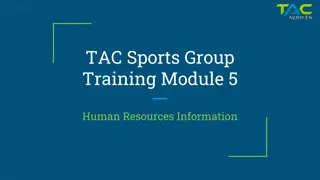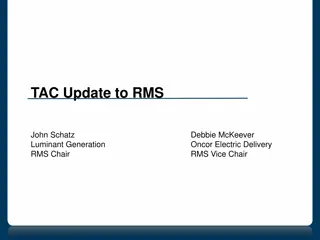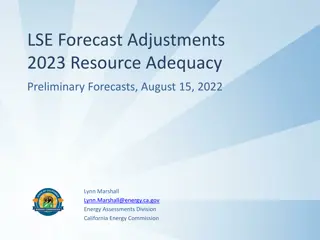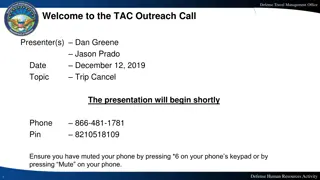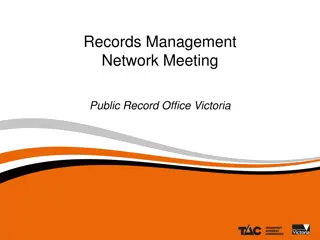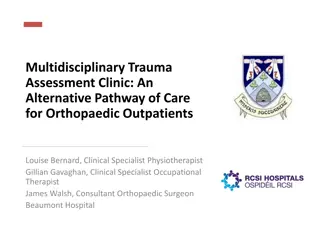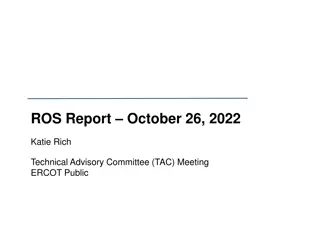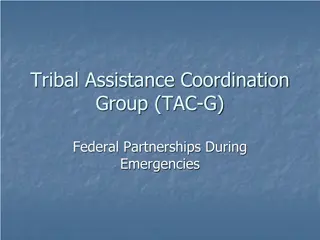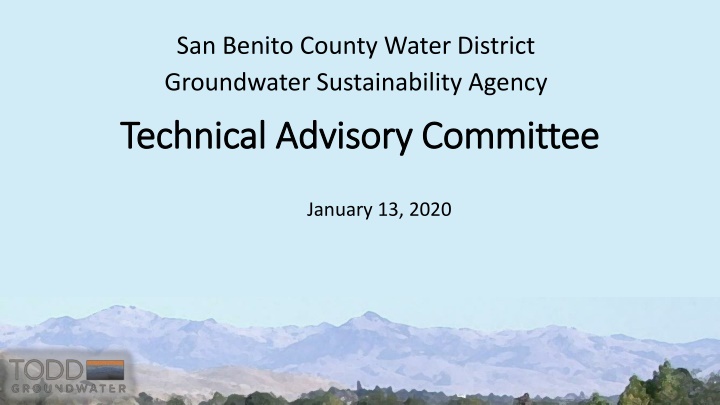
Overview of San Benito County Groundwater Sustainability Agency Meeting
The San Benito County Water District Groundwater Sustainability Agency held a Technical Advisory Committee meeting discussing various topics such as updates on the Groundwater Sustainability Plan schedule, water budget numerical models, sustainability criteria, and future simulation methods. The meeting also covered reports on water quality, model improvements, results of grower meetings, and simulations of future conditions as required by SGMA regulations.
Download Presentation

Please find below an Image/Link to download the presentation.
The content on the website is provided AS IS for your information and personal use only. It may not be sold, licensed, or shared on other websites without obtaining consent from the author. If you encounter any issues during the download, it is possible that the publisher has removed the file from their server.
You are allowed to download the files provided on this website for personal or commercial use, subject to the condition that they are used lawfully. All files are the property of their respective owners.
The content on the website is provided AS IS for your information and personal use only. It may not be sold, licensed, or shared on other websites without obtaining consent from the author.
E N D
Presentation Transcript
San Benito County Water District Groundwater Sustainability Agency Technical Advisory Committee Technical Advisory Committee January 13, 2020
Overview of Agenda Overview of Agenda Update on GSP schedule and progress Revised Water Budget Numerical Model Sustainability Criteria: Water Quality TAC next steps
Update Update Last TAC Meeting Water budget Sustainability goal statement Annual Groundwater Report for 2019 Water quality update Transition to fulfill SBCWD and SGMA requirements
Model Improvements Model Improvements Met with Bolsa growers in November Implemented new 86-year simulation method for future conditions
Results of Bolsa Grower Meeting Results of Bolsa Grower Meeting Revised cropping history in Bolsa and nearby areas Changed irrigation assumptions Pasture (irrigated to non-irrigated) Shorter growing season in Bolsa Shifted vegetable crop season more to summer Increased bare-soil evaporation in winter Recalibrated model
Simulating Future Conditions Simulating Future Conditions The model and ancillary spreadsheets have been simulating a 43-year period (1975-2017) SGMA requires exactly 50 years in the future analysis period A concurrent model application (Pacheco Reservoir) needs simulation of 1922-2003. Solution: two successive 43-year simulations covering 1922-2007 hydrology
Simulating Future Conditions Simulating Future Conditions 2 2 Assumptions for future baseline simulation: Existing land use (urban footprint, crop types) 1922-2007vrainfall, ETo and stream flow CVP availability from DWR s CalSim II model Current CVP treatment capacity Target CVP/GW use for muni supply is 70%/30% Initial water levels = September 2012 (typical)
Simulating Future Conditions Simulating Future Conditions 3 3
Water Budget Revisions Water Budget Revisions Tables are slightly different, but relationships among analysis periods and management areas are mostly unchanged. Irrigation pumping estimates mostly slightly higher because of summer-weighting of vegetable crops.
Water Budget Revisions Water Budget Revisions
Water Budget Revisions Water Budget Revisions
Water Budget Text Revisions Water Budget Text Revisions Response to Comments on water budget section Storage in Southern MA Added discussion about future assumptions Added units and consistent labels to figures
Sustainable Yield Estimate Sustainable Yield Estimate Same method: Based on future baseline simulation Yield = simulated pumping + simulated net storage change Net storage change zero, so yield = pumping Caveat: sustainable yield can be constrained by the occurrence of undesirable results, separate from this water balance approach.
Sustainable Yield Estimate Sustainable Yield Estimate Revised estimates about 10% larger than previous estimates Future Baseline 2018-2067 Agricultural Pumping 39,043 18,350 29,737 94,041 M&I Pumping 5,627 6,445 Management Area TOTAL Southern Hollister San Juan Bolsa TOTAL 6,911 142 7,053 44,670 19,002 29,761 100,486 652 24
Numerical Model Numerical Model Model will be documented in a GSP appendix Grid Recharge pre-processing Recharge/Runoff equations Irrigation and consumptive use details Boundary conditions Hydraulic parameters Calibration
Numerical Model Numerical Model Model Layer 1 Faults 200 rows Streams WWTP percolation and bedrock inflow Drains Inactive 271 columns
Model Layer 3 Faults Wells General-head boundary
Rainfall-Runoff-Recharge Polygons Numerical Model Numerical Model
Rainfall ET Rainfall Rainfall- -Runoff Runoff- -Recharge Model Recharge Model Disconnected Impervious Runoff Irrigation Connected Impervious Runoff Infiltration Direct Runoff Direct Runoff Municipal Water and Wastewater Water Pipe Leaks Sewer Pipe Leaks ROOT ZONE Nonirrigated Deep Irrigated Percolation SHALLOW GROUNDWATER ZONE Baseflow Recharge REGIONAL AQUIFER SYSTEM
Calibrated to Measured Hydrographs Calibrated to Measured Hydrographs 77 hydrograph wells
Calibrated to Measured Hydrographs Calibrated to Measured Hydrographs While some hydrographs are better simulated than others, the model calibration meets standard expectations.
Calibrated to Measured Hydrographs Hydraulic Conductivity and Hydraulic Conductivity and Storativity Storativity Zones Zones
Sustainability criteria for groundwater quality Sustainability criteria for groundwater quality Topics Brief background Undesirable results Minimum thresholds Measurable objectives Management actions and monitoring Key definitions
Background on groundwater quality Background on groundwater quality Focus on TDS and nitrate; other constituents tracked, too Ambient TDS already exceeds drinking water standards and/or Basin Plan objectives in many wells Long-term TDS data do not show water quality deterioration Legacy salt and nitrate loading means that groundwater quality can get worse despite reduced loading and management actions GSA role includes Monitoring and reporting Cooperation with water quality regulatory agencies, e.g., RWQCB Prevention of undesirable results from basin management actions or projects
Undesirable results: TDS and Nitrate Undesirable results: TDS and Nitrate Undesirable results involve degradation of water quality that adversely affects beneficial uses TDS and nitrate: drinking water supply for municipalities and domestic users TDS: irrigation water quality Nitrate: impacts on connected surface water (algal growth, eutrophication) Potential sources include Salt loading from irrigation, urban and domestic use (e.g., water softening) and need for basin outflow Nitrate loading from fertilizers, municipal wastewater disposal, domestic septic systems, animal wastes
Minimum Thresholds Minimum Thresholds Minimum thresholds for water quality to be defined in terms of: Constituents of concern determined by the GSA TDS Nitrate Other constituents are considered native and/or not significantly or unreasonably affected by basin management Number of supply wells, volume of water, or an isocontour SBCWD monitoring is based almost entirely on supply wells and were identified to represent supply wells
Setting minimum thresholds Setting minimum thresholds Municipal1 Ag2 Parameter Units RWQCB General Basin Plan Objectives TDS mg/L 500/1,000/1,500 450 Nitrate (as NO3) mg/L 45 100 Basin-Specific Basin Plan Objectives Tres Pinos (now Southern MA) 1,000 5 22.5 Hollister (Bolsa and San Juan) Parameter Units TDS Nitrogen (as N) Nitrate (as NO3) mg/L mg/L mg/L 1,200 5 22.5 1. Municipal levels for TDS are recommended levels 2. The Agricultural objectives for nitrate are recommended for livestock watering
Applying minimum thresholds to available data Applying minimum thresholds to available data Two data sets are available: 1. District monitored wells Sampled to track trends, detect exceedances, support analysis of causes About 29 wells, including the nested well Wells in general are regionally representative and show historical trends But some wells track local problems and have highly variable data
Response to exceedance of minimum threshold Response to exceedance of minimum threshold Short-term action is triggered when a District monitored well shows: Two or more consecutive exceedances at regular sampling events Statistically significant increasing trend over five years Short-term monitoring actions: SBCWD monitoring program will be improved with more sites, dedicated wells, and rigorous protocols SBCWD will investigate samples/wells with an increase above minimum threshold or a significant increasing trend
Applying minimum thresholds to available data Applying minimum thresholds to available data 2. Triennial update data set Larger data set from multiple agencies compiled on triennial basis Set of sampled wells varies over time, but more sites and widely distributed Provides a snapshot and overview of TDS and nitrate Number of Wells with Nitrate or TDS Data, 2015-2017 Constituent Southern MA Hollister MA San Juan MA Bolsa MA Total Nitrate (as NO3) 19 121 81 35 256 Total Dissolved Solids 11 108 63 31 213
Sustainability Sustainability Unsustainability Unsustainability (undesirable, unreasonable, significant) (undesirable, unreasonable, significant) Definition of: Definition of: MT How many supply wells with concentrations exceeding the minimum threshold (MT) indicate that the basin is in an unsustainable condition? Consider current conditions 2015-2017 as the start: Minimum Thresholds (from Basin Plan) Percent Wells with Median Concentration over MT Constituent Southern MA Hollister MA San Juan MA Bolsa MA Nitrate (as NO3) 45 mg/L 5% 14% 26% 11% Total Dissolved Solids (Hollister, San Juan, Bolsa) 1,200 mg/L --- 24% 46% 26% Total Dissolved Solids (Southern MA only) 1,000 mg/L 55% --- --- ---
Sustainability Sustainability Unsustainability Unsustainability (undesirable, unreasonable, significant) (undesirable, unreasonable, significant) Definition of: Definition of: MT Apply the minimum threshold to triennial data. The definition for nitrate* is a statistically significant increase, relative to current conditions, in the median percentage of wells exceeding the minimum threshold (Basin Plan Objective) for nitrate, as indicated in the triennial update. and a statistically significant increasing trend in the nitrate concentration in 15% or more of the District monitored wells over a five year period. This makes good use of District monitored well data. *Use the same definition for Total Dissolved Solids.
Setting measurable objectives Setting measurable objectives RWQCB General Basin Plan Objectives Municipal1 500/1,000/1,500 45 Ag2 450 100 Parameter TDS Nitrate (as NO3) Units mg/L mg/L Tres Pinos (now Southern MA) 1,000 5 22.5 Basin-Specific Basin Plan Objectives Hollister (Bolsa and San Juan) Parameter Units TDS Nitrogen (as N) Nitrate (as NO3) mg/L mg/L mg/L 1,200 5 22.5 1. Municipal levels for TDS are recommended levels 2. The Agricultural objectives for nitrate are recommended for livestock watering
Monitoring and management actions Monitoring and management actions Short-term monitoring actions Monitoring program will involve more sites, vertical monitoring, consistent protocols Investigate samples/wells with an increase above minimum threshold or a trend These short-term actions will inform long-term actions Long term management actions Increase CVP percolation, Managed Aquifer Recharge of local surface and stormwater Improve monitoring program Continue SNMP and ILRP Maintain groundwater outflow Cooperate with County on OWTS and wastewater treatment/disposal Continue and expand water softener conversion to cartridge type Encourage use of non-gypsum soil amendments Improve irrigation practices to reduce loading; e.g., decrease sprinkler spray evaporation
Key definitions Key definitions Measurable objectives refer to specific, quantifiable goals for the maintenance or improvement of specified groundwater conditions that have been included in an adopted Plan to achieve the sustainability goal for the basin. Minimum threshold refers to a numeric value for each sustainability indicator used to define undesirable results. Undesirable results occur when significant and unreasonable effects for any of the sustainability indicators are caused by groundwater conditions occurring throughout the basin. The description of undesirable results shall include the following: 1.The cause of groundwater conditions occurring throughout the basin that would lead to or has led to undesirable results based on information described in the basin setting, and other data or models as appropriate. 2.The criteria used to define when and where the effects of the groundwater conditions cause undesirable results for each applicable sustainability indicator. The criteria shall be based on a quantitative description of the combination of minimum threshold exceedances that cause significant and unreasonable effects in the basin. 3.Potential effects on the beneficial uses and users of groundwater, on land uses and property interests, and other potential effects that may occur or are occurring from undesirable results.
GSP Overview, Workshops, and TAC Meetings Adoption hearing Plan Development 2021 Draft GSP workshop Management Actions / Monitoring Implementation workshop 2020 Sustainability Criteria Actions workshop Criteria workshop Management Areas / Water Budgets Water budget workshop February 25 2020 Hydrogeologic Conceptual Model / Groundwater 2019 HCM-GW Conditions workshop June 18 2019 Data Compilation / Data Management System Kickoff workshop Nov 7 2018 2018 Plan Area / Institutional Setting
Next Steps Next Steps SBCWD Board of Director s Meeting: Annual Report with Water Quality Update January 13, 2020 Public Workshop No. 3 Water Budget February 25, 2020 TAC Meeting No. 8 Sustainability Criteria April 29, 2020


